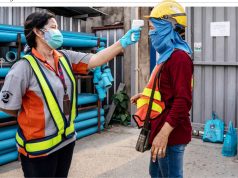The world is going through a severe food shortage, say the experts, citing reasons such as growing population, lack of virgin land and dramatic climate change. More than one billion people are chronically hungry. The oceans are overfished and a large part of the world faces growing water short- age.
To meet the challenge of escalating food crisis algae farming seems to be the answer. Algae are simple, single-cell organisms that can grow very rapidly at sea, in polluted water and in places that would normally kill food crops. Algae are very diverse and found almost everywhere on the planet. Algae can be grown using water resources such as brackish-, sea and wastewater unsuitable for cultivating agricultural crops. They play an important role in many eco-systems, including providing the foundation for the aquatic food chains supporting all fisheries in the oceans and inland, as well as producing about 70 percent of all the air we breathe.Today, major airlines and shipping companies are now investigating a switch to algae oil, and smart clean tech money is pouring in to the nascent technology.
Algae are suitable for cultivation and production. Nation First International Development Asia (NFIDAsia) had intention to facilitate algal based farming products throughout rural Myanmar. NFIDAsia president Johnathan Pierce said, “The NFIDAsia Company is not a business which will take Myanmar’s money out to other countries. The project will be beneficial for local people”. He added,“We will grow the algae, manufacture it locally and distribute the finished products around the world. The company will not manufacture the products in other countries by only taking the raw materials.”The president also said that the company has been successfully operating the algae farming businesses in several countries like Japan, US and Israel.
Algae are a profitable source of bio-fuel and commercial animal feed for aquaculture and agriculture. It can also be a sustainable source for a broad range of high profit value products. Production of spirulina, a fresh water algae consumed by both humans and animals, is being carried out in Butalin Township of Sagaing region, in upper Myanmar and it’s widely used as a nutritious food in 70 countries. Since 1987, commercial Spirulina production from the Twin Taung Lake has been providing its domestic market a range of healthy food, at the same time stimulating the local’s economy growth. Natural Spirulina can be found in several crater lakes around the world such as in Mexico, Africa, and Myanmar.
Spirulina improves physical growth as well as cognitive development. It also improves immunity, and therefore helps in fighting and preventing HIV/AIDS and anemia be- cause it contains most essential micronu- trients in high concentrations so one gram per day can combat malnutrition within a month. Studies show it is also effective against arsenic poisoning. Besides, spirulina can be consumed directly as the paste which is harvested or dried and is easily digested. It’s sold in the form of pills or is combined with various food products such as rice, milk products, energy bars, candy, noodles, etc. In Myanmar, spirulina production was started 25 years ago by Dr. Min Thein, a professor of Botany at Mandalay Universitty. In 2011, he received the Senior Life Time Achievement Award in Microalgal Biotechnology during the 5th International Algae Congress in Berlin, Germany. His company, June Pharmaceuticals, produces about 200 tons of spirulina per year. Most remark- ably, the company has developed the most impressive range of innovative consumer products with spirulina, including food supplements, functional foods and bever- ages, cosmetics and personal care products, biofertilizer and even spirulina beer. It is believed that the combination of spirulina and beer can cause an anti-aging effect. In recent years, there have been many personal care products that have added spirulina into it. It’s due to the fact that spirulina is rich in protein, Gamma Linelinic Acid(GLA), beta-carotene, enzyme and other micronutrients. It is also said that spirulina helps in detoxification of various parts of the body. Also, it lightens the contour, moisturizes skin, and evening has a calming effect.
Spirulina has social and economic benefits as well. Not only it’s cheap to produce because it requires much less water to grow than vegetables but also uses simple technology and locally available materials. Moreover, it stimulates the education of local women about nutrition. Spirulina programs are currently being implemented in many African countries, Madagascar, Mali, India, and Vietnam. One example of a successful business initiative revolving around Spirulina production can be seen in Madurai, India. Here 15 women run a production facility of 40 Spirulina tanks. They work to produce 150kg of spirulina per month. They pack the Spirulina in dry form of 2 gram sachets and sold to two local NGOs.
The Spirulina is also combined with millet, jaggery, and sesame to produce a type of energy bar to feed 2000 children per day from slums in the neighborhood. At this scale of production, the facility is extremely efficient, and produces at a cost of 0.01 euro per child per day.
Algae farming can be carried out at places like fish farms. A USDA lead scientist recently as the potential solution to the challenge of a limited supply of fish feed that can be taken from the ocean and the limited supply of fishmeal ingredients. It has been proved that aquaculture is now providing more fish for human consumption than wild har- vested fish due to growing demand for fish feed. Fishmeal provides an excellent source of highly digestible protein, beneficial fatty acids and essential vitamins and minerals. According to a research report on algae farming, by choosing the algae with the highest protein content, the producers can reduce the overall pricing of its feed by mixing algae biomass with other feed sources such as soy or corn, while maintaining a digestibility that would assure maximum growth of their aquatic crop. The digestibility determines the metabolic processes that induce growth in aquatic species for a given set physical and chemical conditions. The better the digestibility, the faster the growth, this is the reason for which there are anecdotal reports of increased production on aquaculture operations after switching from mostly corn/ soybeans feed to algae feed.










